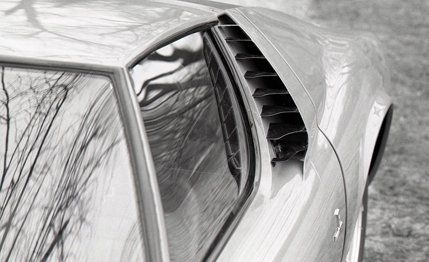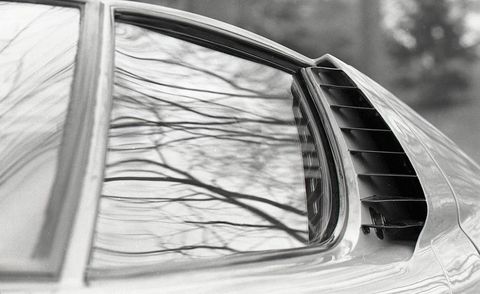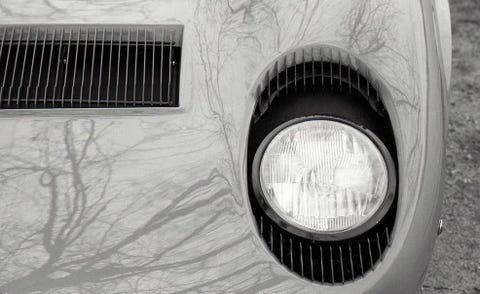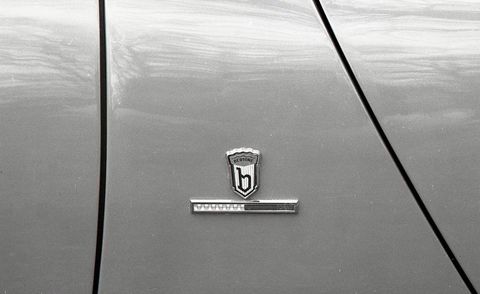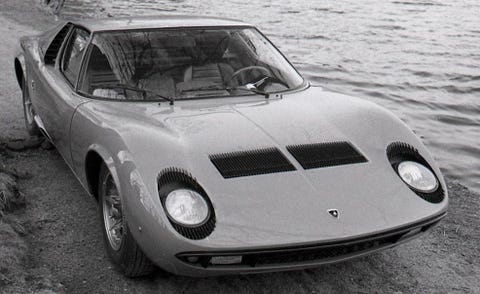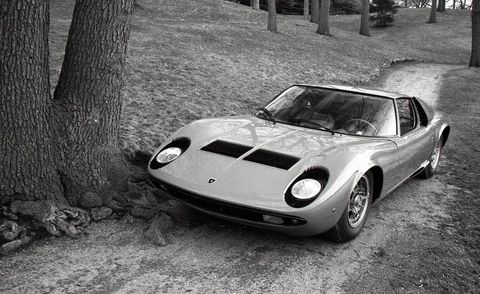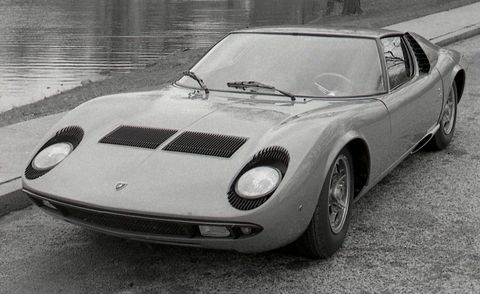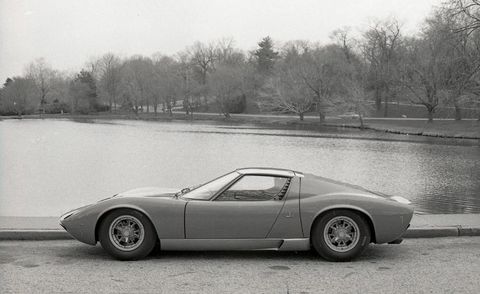From the August 1967 issue of Car and Driver.
We don’t know what’s going to happen when Dr. William Haddon and his auto “safety” experts come face to face with the Lamborghini Miura. For starters, “Miura” is a breed of Spanish fighting bull, and the wild Miura, with its 430-horsepower, V-12 engine mounted transversely in the rear, is so bold, individualistic and unconventional that it’s hard to imagine it fitting into anybody’s arbitrary standards, safety or otherwise.
Difficult though the challenge may seem, we believe the normal Lamborghini 350 GT (C/D, March 1966) and perhaps even the Miura will be modified to conform to any standards the National Traffic Safety Bureau will impose. That’s the kind of commercial competitor Ferruccio Lamborghini is. As a self-made man—a successful manufacturer of tractors, heating units, and air conditioners—Lamborghini’s sole objective in the automobile business (expense be damned) is to surpass Ferrari, first in sales, and then in reputation. He’ll do what he needs to do to sell cars in the rich American market. If his two American importer-distributors agree that there should be different headlights or an optional automatic transmission, they let Lamborghini know, and behold—the necessary modifications are made with a rapidity that would astound those familiar with the normal reaction times of Italian auto‑makers, especially the smaller firms.
There’s also a no-nonsense atmosphere about the Lamborghini representation here. East of the Mississippi the car is imported by Jake Kaplan’s Lamborghini East, at 464 Broad Street in Providence, Rhode Island. In the west, you order your Miura from Bob Estes, 964 South La Brea Avenue in Inglewood, California.
Each distributor expects to get six cars during 1967, so there may be a dozen in the country—Miuras, that is—before the famous safety standards come into effect. No matter where you live, you don’t have to worry about service. Kaplan’s procedure for Lamborghini owners as far away as Philadelphia is to send down a driver in a Cadillac who takes the Lamborghini away and leaves the Caddy as a loaner until the job is finished. You can’t be taken care of much better than that. They might even leave you one of the many Ferraris that have been traded in on the smooth, quiet and quick front-engined Lamborghini 350 GTs.
There are only two other cars that can be mentioned in the same breath with the Miura. They are the Ford Mark III (C/D, June 1967) and the Ferrari 275/LM (C/D, May 1965). Both are available in road versions, but were originally built for the track, where they will always be more at home. The Miura, on the other hand, was engineered with racing as a future possibility, but was developed solely for the street. As such, it is superior in performance, space and furnishings—in everything, in short—to the other twenty-grand two-seaters.
Why is this racy car not racing? Because Lamborghini isn’t interested. One well-heeled owner asked the factory to prepare one of the front-engined cars for Le Mans this year, at the owner’s expense, but they wouldn’t touch it. Lamborghini sees no sense in being crushed between the Ford and Ferrari juggernauts. Instead, Ferruccio Lamborghini has sought to establish a reputation of his own through advanced engineering and styling plus unusual refinement. He has handsomely scooped Ferrari in building road cars with all-independent suspension, with four overhead cams, with tranverse-mounted rear engines. His styling may seem bizarre—certainly more bizarre than Ferrari’s—but it’s all integrated to one end: comfortable high-speed touring. And the cars run with a silky smoothness that is satisfying to professional and business men who have outgrown the childish kick of rapping the exhaust in an underpass.
Lamborghini’s design staff, led by its youthful chief, Gianpaolo Dallara, had prepared complete drawings for the chassis of the Miura-to-be by the summer of 1965, choosing the transverse layout as the best way to accommodate Giotto Bizzarrini’s big V-12 design in the back of a small sports car. In October, photos of the engine/gearbox were released, and in November, 1965 a chassis was put on display at the Turin Salon. On the basis of this unclothed chassis, and in spite of a very high projected price, 10 orders were booked at Turin for this new Lamborghini, so compelling were its exotic mechanicals alone.
The production chassis differs quite a bit from that first showpiece. The wheelbase was lengthened from 96.9 to 98.4 inches, and the radiator was placed conventionally instead of horizontally, as at first. The battery was moved out of the central frame tunnel and into the front compartment to improve weight distribution—now 44.5/55.5% with a full tank of gas (the front end lightens as the tank empties). Other detail changes included pivoting the accelerator from the floor instead of a suspended mount.
Understandably, more than one bodybuilder was interested in having the honor of clothing this ingenious chassis. The assignment finally went to Nuccio Bertone, one of the most creative designers working in sheet metal today. It should be explained that bodybuilders work in close collaboration with Lamborghini’s designers, which explains the unusual way the Miura’s mechanicals and aesthetics are blended into an organic whole. The body was first shown at Geneva in March, 1966 and by May, the car was undergoing its first running tests.
At the Paris Salon in 1966, the Miura appeared in near-final form, and arrangements for production were completed. Originally, the scheme was to make 50 Miuras in 1967, but the reception at the fall shows was so enthusiastic that Lamborghini decided to increase the target to 100. (This will be in addition to 250 of his front-engined cars.)
Production arrangements for the Miura are simplified by clever design which makes use of many bits and pieces from the standard Lamborghini. The biggest such bit is the engine, a 60° V-12 with a deep-sided aluminum block carrying wet cylinder liners. At 82 x 62 mm for 3929cc, it’s substantially overs square—much more so than the four-liter Ferrari V-12, which measures 77 x 71 mm. Four chain-driven overhead cams work the valves through cup-type tappets. The cam timing of the sprint-tuned engine, as fitted to all Miuras being brought to the U.S., gives a 308-degree inlet duration, 280-degree exhaust, and an overlap of 90 degrees. The compression ratio is raised to 10.2 to one from the more normal 9.8. The engine comes “on the cam” at about 4500 rpm, reaches the torque peak at 5900, and achieves its peak output of 430 horsepower at 8000 rpm.
Carburetion is by downdraft Webers (identical to the 46 IDA3Cs used on the Porsche 911), their ram tubes concealed inside the long air cleaner/silencers. The four carbs have three throats and two float bowls apiece. Somehow, room has been found for an effective exhaust system, with headers feeding into a transverse muffler, under heat shielding at the back, with two short tailpipes. A wet sump lubrication system without an oil cooler was found adequate for the roadgoing Miura, although there had been talk earlier of a dry sump layout for the 430-hp engine. Up front, the wide crossflow radiator is backed by two big plastic-bladed Lucas cooling fans which the driver can switch on as required.
Within its aluminum casing running along the backside of the engine, the transmission uses the same helical gearing and Porsche synchromesh for all five forward speeds and reverse as used by Lamborghini in his front-engined cars. A very small pinion and a very large ring gear, also helical, take the drive out of the gearbox to the limited-slip differential, thence to the wheels by conventional splined halfshafts.
When the Miura was first shown, it had a special triple-plate clutch at the input shaft of the gearbox, driven by one-to-one gearing from the crankshaft, all of this happening on the left side of the car. This layout, which is shown in the drawing that opens this article, has been superseded on the production cars by an arrangement more like the BMC Mini’s. The clutch is now a simpler single-plate unit at the end of the crankshaft, driving the gearbox input shaft through a pair of helical gears. This more rational layout is shared with the new two-liter transverse-six Marzal (C/D, June 1967). The alternator, driven before by gearing, has been moved to the right end of the engine where it’s rotated by a toothed rubber belt.
Even the suspension of the Miura has been successfully adapted from the front-engined Lamborghini. Coil springs concentric with Armstrong shock absorbers are used at all four wheels, attached to the lower wishbones in each case. The wishbones are steel pressings, with the lower ones boxed for added strength. The front arrangement is conventional; the bottom wishbones at the back are reversed, as on many Formula One cars, with a trailing link to take the drive thrust. At both ends of the car the wishbone planes converge markedly and provide a high geometric roll center. Roll resistance is increased further by anti-roll bars at front and rear, 3/4- and 5/8-inch in diameter, respectively.
Mounted ahead of the front suspension is the rack-and-pinion steering gear, which carries a tubular damper to soak up road shock feedback.
Girling provides the cylinders and calipers for the dual-circuit disc brake system, working without a power boost on 12-inch discs. The absence of power assistance on a fast road car is surprising at first, but the brake linings were selected to be just soft enough to provide a good bite without permitting fade. Good ventilation is afforded by the ducted and ribbed magnesium alloy wheels, mounted on knock-off hubs.
On a car like the Miura, tires are all-important, not only for cornering but also for the very high speeds of which the machine is capable. One of the few tires in the world that will do the job on this car is the Pirelli Cinturato HS, in size 205 VR 15. The “VR” is the tip-off that this tube-type tire is made for extremely high speeds. In fact, these tires are rated safe for continuous speeds to 165 mph, and for intermittent use above that speed. The VR tires aren’t normally sold by Pirelli in the U.S. because their wear factor—with the thin tread needed for high speed—-isn’t too favorable.
Totally exotic in concept, the Miura is highly practical in execution. For example, the design of its frame is the simplest, most direct way of tying all the car’s parts together in a rigid structure. Drawing on techniques used in the design of an experimental Lamborghini helicopter, Dallara laid out a deep-section platform frame spot-welded of .032-in. sheet steel. Stiffness in all planes is augmented by the center tunnel and the deep side sills, pierced for lightness wherever possible.
At the front, a trapezoidal-section extension takes the suspension stresses. At the rear, four boxed arms reach back above and below the axle shafts, creating a very rigid enclosure for the 550-lb. engine/gearbox unit. The frame, which resembles an experimental Chevrolet design for the Monza GT and SS two-seater Corvairs, weighs 155 lbs.
The contours of the Miura are classical Italian, with just enough sharpness in the fender peak lines, in the American manner, to keep it from looking soft. Bertone’s “eyeball aerodynamics” are evidently very sound, as the original shape, with its chopped tail and just a hint of a spoiler on the trunk lid, went into production without change after proving stable· at speeds in excess of 185 mph. About the only major alteration was in the rear window, which was changed from glass to a series of aluminum louvers in the style of the Monza GT Corvair and the Mako Shark II. In the Miura, these allow air from the side scoops to flow through the engine room, effectively carrying away engine heat.
Bertone’s bodywork is entirely aluminum, and the collaboration of the Lamborghini staff is shown in the aircraft-type pierced-sheet structure within the front and rear body sections, which pivot up for access to the internals. Each is held in place by two stout latches.
On the car we examined, all the metallic trim pieces were painted black, which we thought was very effective and appropriate on this car. We’re told that future Miuras will be “black-chromed” on such parts, which should look even better—especially to Dr. Haddon and his anti-glare regulation. The two grilles in the front deck exhaust warm.air from the back of the radiator, and the right one hinges up to expose the gas filler cap. Separate electric motors raise the Carello headlights into operating position.
Getting in and out of the 41.5-inch-high Miura isn’t a graceful process, but it’s far easier than with the Ford GT Mark III. The lightweight door opens wide, carrying with it the rear grillework (a portion of the door that helps stabilize the side glass, keeping air leakage and resultant wind noise to a minimum). Remarkably for such a car, the side glass can be rolled down out of sight, though an impossible number of crank turns are needed to do so and the imposing looking winders are awkward to handle without scraping the adjacent leather trim. Electric lifts would cure this fault.
The gently reclining leather-trimmed bucket seats are lightweight and supple, more than comfortable enough for the short length of time it takes to get anywhere in the Miura. A 6′ I” driver is a snug fit in the driver’s seat, hair just brushing the roof. The pedal layout is not too good, requiring a bent position for the right leg against the accelerator, which could have been farther forward to good advantage. Heel-and-toeing is also highly awkward. Lack of competition breeding was further evident in the absence of a “dead pedal” on the left (a notch or member against which the left foot can be braced while cornering). For normal touring, for drivers significantly shorter than six feet, the pedalerie is acceptable, but only that.
Placed a little low for best legibility are the two big housings for the Jaeger speedometer and the 10,000-rpm tachometer. In a center panel are six additional dials including a clock-all angled toward the driver. Below them is a parade of nine indicator lights, each a different color to associate it with a particular light, level or warning function. A sexy yet practical touch is the switch panel mounted in the roof, Avanti-style, just above the rear-view mirror. The six switches control the headlights, fog lights, dash and interior lights, the single-speed heater-ventilator fan and the radiator cooling fans. No, Dr. Haddon, they’re not labelled.
Between the Geneva and Paris shows, 1966, Bertone concentrated on improving the ventilation and soundproofing of the passenger compartment. Air comes in under either ram or fan pressure and is ducted through the central tunnel to outlets by the feet and high between the seats. These outlets are fully and individually adjustable for volume and direction. If you want heat, you turn a tap under the dash which lets water into the heater core. It’s a simple and effective system.
Bertone tried several different ways to let air out of the cockpit, finally adopting vents across the back of the roof like those on the Ford GT. A simple slide-valve opens or closes this from the inside. These arrangements are very effective, even on the warmest days, and with full-opening side windows, you can get plenty of air into the car when you want it. Normally you’ll open the windows only an inch or two, and that only at low speeds.
A special rubber insulation is used in the Miura’s firewall, which does a fine job on both noise and heat. It’s never more than slightly warm to the touch. For the all-important inside rear window, Bertone tried double-walled glass separated by a special gas. It worked well, but was replaced on production models by a double-thickness plexiglass window called “Visarm.”
Other Miura cockpit features include triple defroster outlets for the wide windshield and a multi-position footrest for the passenger, who also has two grab rails and a package shelf on his side. On this car, serial number 0979, such internal hardware as the recessed door latches and the ashtray had been painted black, and were already looking a little tatty from use. Black chrome may be the future solution here too, to keep your Miura looking new for longer.
One or two pumps of the throttle prime the Webers enough for a near-instant light-up, the engine quickly settling down to a smooth, muttering idle. Once the initial slack in the primitive-looking throttle cable is taken up, the engine’s response to the rather stiff accelerator pedal is startlingly quick. It feels inertia-free, and revs with breathtaking response.
Amazingly little engine noise intrudes on the Miura’s occupants—amazing when you consider you merely have to turn your head to see a bank of carburetors only inches away. When the car’s on the move, you’re aware of a subtle mixture of enjoyable mechanical sounds -a blended whirring of cam chains, drive gears, and Pirelli tire treads, backed by the remote bass rumble of the exhaust. Inlet and exhaust noise are heightened, of course, at full throttle and high revs, but even then conversation is possible and under most conditions, a radio would be considered a useful option. Wind noise is nonexistent at any speed you could ever use on the highway.
Occasionally, there’ll be a part throttle pop from one of the carburetor inlets, barely audible through the Visarm window. A minimal amount of road and body murmuring lets you know what kind of road surface the Miura is running on, but otherwise, the car has a remarkable feeling of solidity. Dallara’s deep frame does an outstanding job.
Lamborghinis, we’re told, have gearboxes that get progressively lighter with use. The Miura’s was very stiff when it arrived in the U.S., and still required quite a bit of muscle, although even during our two-hour run there seemed to be a lessening of the force needed to get past the Porsche synchro rings. The stick is spring-loaded to the middle or 3 – 4 slot of the gate, giving the driver a sensory clue to its orientation. It’s a strong box with fine ratio spacing-first gear is just right for a smooth getaway-but the gearshift effort is not the most endearing feature of the car. The clutch pedal has a slightly dead feel but is light in use, and its take-up is entirely smooth and normal.
Racing-type starts produce vivid performance, totally without wheelspin—unless one indulges in brutality for the sake of brutality. We didn’t flagellate this Miura, but the one tested in Switzerland by Automobile Revue reached 60 in 5.0 seconds, 100 in 11.7, and 150 in 32.5 seconds with the lower-performance 350-hp engine. Our 430-hp car felt just as strong up to 100, but from there on, it really thrust forward—125 in third, 145 in fourth and quite a bit more in fifth.
The Miura’s acceleration is, like Rolls-Royce’s power, “adequate.” The car will literally do whatever you want. Just as impressive, however, is the engine’s smoothness and flexibility. You can pull away without bucking from 1000 rpm in top gear on part throttle, and apply full throttle at about 2000. At 60 mph you can cruise in any of the top four gears, depending on what you think you may have to do next; it makes no difference to the Miura. In traffic there is no temperament, none at all. When you leave the city limits you step on it and away it goes.
In front of the Miura driver is a small wood-rim steering wheel, placed high and at an angle that indicates it’s there to be rotated and manipulated, but not to be hung 0n to. For us there was slight awkwardness about the wheel position—just enough to make us think that a car of this price should have some adjustment for wheel angle and distance, especially when every interior inch counts.
What the wheel does is fine. The steering is light and easy, yet with a positive directional feel. There’s some road feedback—not excessive—and under rare combinations of speed and road surface, a vibration appears, but is quickly damped. At low speeds, say up to 80 mph, the steering ratio seems slow, with 3.75 turns lock-to-lock, requiring some hand-over-hand to get around city corners. Above 120, though, you appreciate that anything quicker would be too sensitive, too touchy, for relaxation at the Miura’s cruising speed.
At all speeds, the Miura feels very stable, thanks to the low center of gravity, excellent tires, and designed-in understeer. It takes corners with such eagerness and total adhesion, so responsively, that under highway driving conditions it’s pointless to talk about steer characteristics or wheel breakaway. It clings leech-like to the road; to corner tighter, you turn the wheel more. Applying either power or brakes in a corner affects the Miura very little, except that it speeds up or slows down. . . a lot.
The Girling brakes are a full match for the speed of the Miura in all highway situations. Without requiring too much pressure, they stop the car in a smooth, straight line, with retardation in close proportion to pedal effort. Like many high-performance disc systems, the Miura’s can be noisy at low speeds around town, emitting an occasional squeal.
Driving the Lamborghini Miura is sheer pleasure. Forward visibility is excellent through the sharply raked windshield and over the sloping hood, and the thin pillars are unobtrusive. Even without outside mirrors, the rear vision through the deck louvers is adequate. We weren’t worried about being overtaken when we reached, on a normal expressway, some 155 mph with the Miura. At 130, we felt pretty heady-until we realized we were only in fourth gear, not fifth!
On the test car’s license plate was the slogan, “Discover Rhode Island.” Let’s see, Rhode Island has about 2000 miles of highway. At an average of 100 mph, that’ll take 20 hours. Well, make it easy on yourself and see it all in three seven-hour driving days. Next, we’ll “discover” Nevada.
This content is created and maintained by a third party, and imported onto this page to help users provide their email addresses. You may be able to find more information about this and similar content at piano.io
Source: Reviews - aranddriver.com







